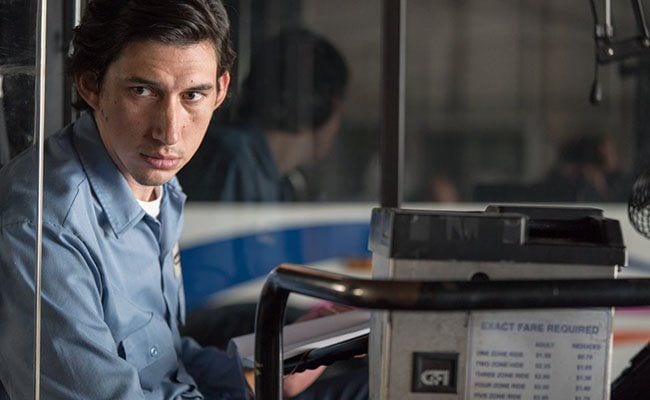
The spark of interest that accompanies a Jim Jarmusch film is reminiscent of a shadow, trailing the film as it makes its way into the world. Here is a filmmaker who compels interest, because if the adage is true that there are only a small number of archetypal stories, Jarmusch offers films with a possible quirky personality and a poetic vision of the world.
If storytelling is a repetitive act, then this an idea echoed in his most recent film, Paterson (2016), about the daily routine of bus driver Paterson (Adam Driver). If there are only so many archetypal stories, one of the reasons is the comparison of films to dreams that C.G. Jung contextualised as helping us to understand the problems we cannot solve in our waking state. Hence, logic would dictate that the same stories are told again and again in order to help the generational confrontation with these cyclic themes.
Patterson’s narrative structure across a week in the life of its character taps directly into this act of repetition that underpins the storytelling process. Yet within this repetitive flow, nuances to his routine are witnessed, his conversations and encounters marking out distinctions from one day to the next. This is not dissimilar to cinema, each film in itself a repetitive act, yet emitting a sense of feeling that gives the impression of distinction from the others that preceded it. The director and their collaborators behind and in front of the camera is an authorial force that infuses a story with this presence. Therein, Paterson’s week becomes a microcosm of storytelling itself, the film on one level self-reflective of the ontology that connects life with storytelling. Jarmusch has crafted a reflection on art and creativity, a rumination on the essence of film itself as a mix of originality and unoriginality.
Indeed, Paterson is an unassuming film, belonging to that gentle and pleasant variety of cinema. This should not be taken as a suggestion that it lacks soul, energy, and passion; rather, there’s a subtle and calm pleasantness that forms the warm folds of the experience. Here we have a deeply thoughtful film, yet one that could pass us by like a ship in the night, so delicate and quier is Jarmusch’s meditation on creativity in the everyday small American town of Paterson.
There’s a tranquility to Paterson that transfixes our gaze, Driver’s character perched on a rock of calmness in a tumultuous surrounding sea of desire. Take his co-worker Donny (Rizwan Manji), who runs off his long list of never ending series of problems, to the rejected and heartbroken Everett (William Jackson Harper), both struggling in the choppy water. We see his girlfriend Laura (Golshifteh Farahani) encourage him to publish his poetry and share it with others, but his reluctance illuminates his character as one rooted in philosophy.
His lack of desire could be seen to echo German philosopher Arthur Schopenhauer’s belief in the emptiness that comes with the fulfilment of desire, yet if we look further East, to the teachings of the Diamond Sutra, there’s an alternative means by which we can perceive Paterson’s nature. Jarmusch and Driver have not only created an introverted character, but one that is extroverted in his intimate connection to man’s spiritual, mystical, and philosophical leanings. One idea in the Diamond Sutra is of life resembling sailing a boat across the ocean, and while we can control the boat, we are unable to control the ocean. Paterson’s daily routine of driving his route, writing his poetry, stopping off at the bar while out walking his dog is reminiscent of the boat under his control.
The day to day events that bring a wind of subtle change and the eventual creative tragedy are, however, reminiscent of the uncontrollable ocean. While Paterson makes choices, he seems content to sail upon the ocean of uncertainty, becoming an embodiment of peace through contentment. It is here that we can observe the significance of Paterson and Laura’s relationship as yin and yang. She offsets his tempered disposition with an emotional one, while attempts to impart her own aspirational creativity onto him expose an additional idea within the shell of this unassuming film.
Jarmusch has told a story here with a heartwarming message that could carry a particular resonance with writers of fiction and non-fiction alike. Paterson’s private poetic expression speaks to how it is an oversimplification to believe that we create for the pleasure of others. Creative expression can be introverted as much as it is an extroverted act. Paterson and Laura resemble the two sides of creativity — the one that craves an audience, the other that does not. Expression is an inherent part of our nature as people and not only do we like to absorb expressions of others on a spectatorial level, but we actively use them as a means to filter the expression(s) of our own personality and aesthetic tastes. Creativity is an act of shaping one’s identity in as much as it is an expression, the creator communicating with both their external world and internal self. The absence of creative expression would deprive the individual of such an opportunity, and so Paterson uses poetry as an outlet of expression that can be pursued in the confines of his small boat upon the ocean.
Here is a film that is not only a reflection on the nature storytelling, but also the idea that just possibly, creativity can take the form of the human personality. It can be the social extrovert or anti-social introvert, Paterson representative of the latter. While art is said to be created with the purpose to be experienced by others, there’s another more intimate and private purpose to it, and here Jarmusch offers a thoughtful and touching celebration of the silent artist.


![Call for Papers: All Things Reconsidered [MUSIC] May-August 2024](https://www.popmatters.com/wp-content/uploads/2024/04/all-things-reconsidered-call-music-may-2024-720x380.jpg)



